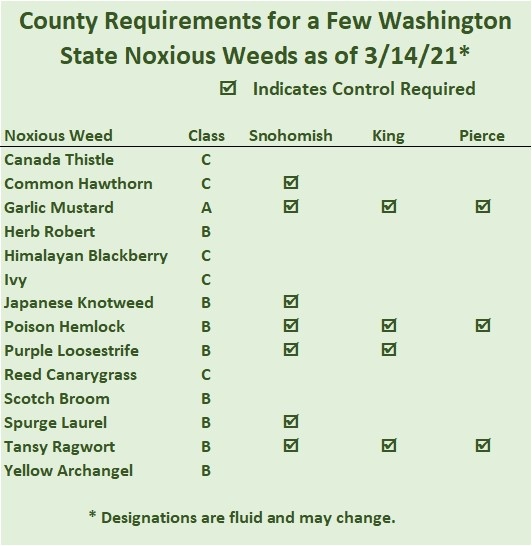Garlic Mustard Tops the State’s List of Backyard Baddies
Recently, the State of Washington’s Noxious Weed Control Board completed its annual update to the list of Class A, B, and C Noxious Weeds. I spent time studying the State’s list and related County lists to see if they affected my forest restoration work.
Class A Noxious Weeds – Eradication Required
Class A weeds are non-native species whose distribution in Washington State is still limited. Eradication of all Class A plants is required by the State. Of the current Class A weeds, I think that Garlic Mustard is probably the most likely to show up in our backyard forests. However, if I come across any plant that I don’t recognize, I’ll make a point to identify it and check it against the State’s list.
Class B Noxious Weeds – Control May be Required
In areas where Class B weeds are already abundant, control is determined at the County level. The County weed control boards respond to the State’s designations and decide whether or not to require control at the County level. Based on a review of their noxious weed websites, it appears that King, Pierce and Snohomish Counties currently require control of Poison Hemlock and Tansy Ragwort. However, these three Counties do not require control of three other Class B weeds that are common in the Puget Lowlands — Scotch Broom, Yellow Archangel, and Herb Robert.
Class C Noxious Weeds – Counties May Require Control
The State does not mandate control of Class C noxious weeds, but the Counties can for reasons like protecting crops. Neither King, Pierce, nor Snohomish County currently requires control of English Ivy, Himalayan Blackberry, or Reed Canarygrass, all of which are designated Class C.
Summary Table
After reviewing the noxious weed websites for the three Counties, I made the following table to summarize my interpretation of whether or not control is currently required for some common backyard forest invasives. Be aware that these designations change from year to year, so I encourage the forest owner to monitor their own County’s noxious weed lists.

Why isn’t control required for more of the common backyard forest invasives? I think it is mainly because they have become so prevalent that mandating control would be unrealistic. That is not the case for Garlic Mustard. The State has continued to list it as a Class A noxious weed, indicating that if we diligently spot it early and completely eradicate it before it can spread, then Garlic Mustard will not become pervasive in our backyard forests.